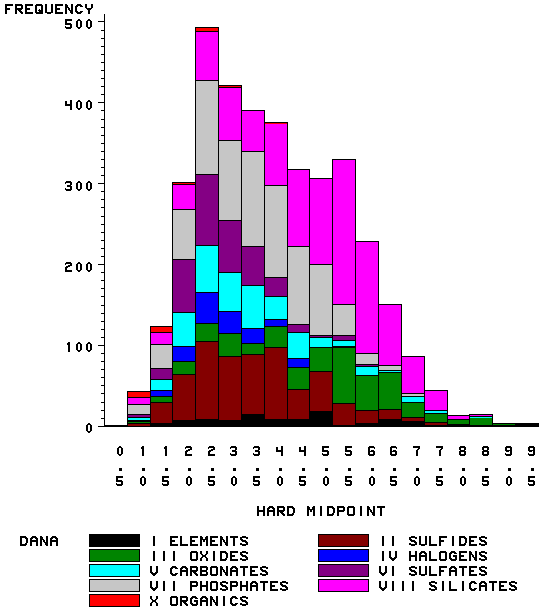Mineral Hardness (original) (raw)
Definition
Hardness is measured by the resistance which a smooth surface offers to abrasion. The degree of hardness is determined by observing the comparative ease or difficulty which which one mineral is scratched by another.
Table showing Mohs' relative hardness scale. Mohs' original hardness values are highlighted in yellow. The selection of mineral species for hardness standards is based on the common availability of the mineral. An interesting observation is the fact that each Dana class (except for organic class) of mineral is represented by at least one example.
| Mohs' Hardness | Mohs' Description |
|---|---|
| 0 | Liquid |
| 1 | Talc |
| 1.5 | Between Talc and Gypsum |
| 2 | Gypsum |
| 2.5 | Finger Nail |
| 3 | Calcite |
| 3.5 | Copper Penny |
| 4 | Fluorite |
| 4.5 | Between Fluorite and Apatite |
| 5 | Apatite |
| 5.5 | Knife Blade |
| 6 | Orthoclase |
| 6.5 | Pyrite |
| 7 | Quartz |
| 7.5 | Garnet |
| 8 | Topaz |
| 8.5 | Chrysoberyl |
| 9 | Corundum |
| 9.5 | Silicon Carbide |
| 10 | Diamond |
Determinative Mineral Tables
Metallic Minerals by Hardness and Streak
Non Metallic Minerals by Hardness and Streak
Graph showing the distribution of hardness values by Dana mineral classification.

For Further Information on Hardness
Search the Mineralogy Database
Example Subject Searches
Example: "hardness-7"" for all minerals with a hardness starting at 7.
Example: "hardness-3.5*" for all minerals with a hardness starting at 3.5
Search the Web
Amethyst Mineral Galleryhas a nice explanation of mineral hardness.